July 17, 2009
Come On In!
As I mentioned on Facebook the other day, the kitchen is now 100% finished. The cabinet company finally delivered (10 weeks after the initial cabinet installation) the correct cabinet front for the dishwasher.
Much better!
We haven’t just been working on the kitchen, though. I’ve already written about the remodeling of the family room and the living room, but I haven’t yet shown the before-and-after shots of another major change we made recently: the new front door. But how major a renovation could that be?! That’s what I thought before we started.
AEJ, who has a very clear vision for how every detail of the house should look (in case you couldn’t tell), hated our front door. To me, it was just kind of regular ol’ front door. I mean, this door is all over the place. But this wasn’t the original door to the house. Built in 1968, this house probably had a somewhat hip door when it was built. That door is long gone, and we were left with this.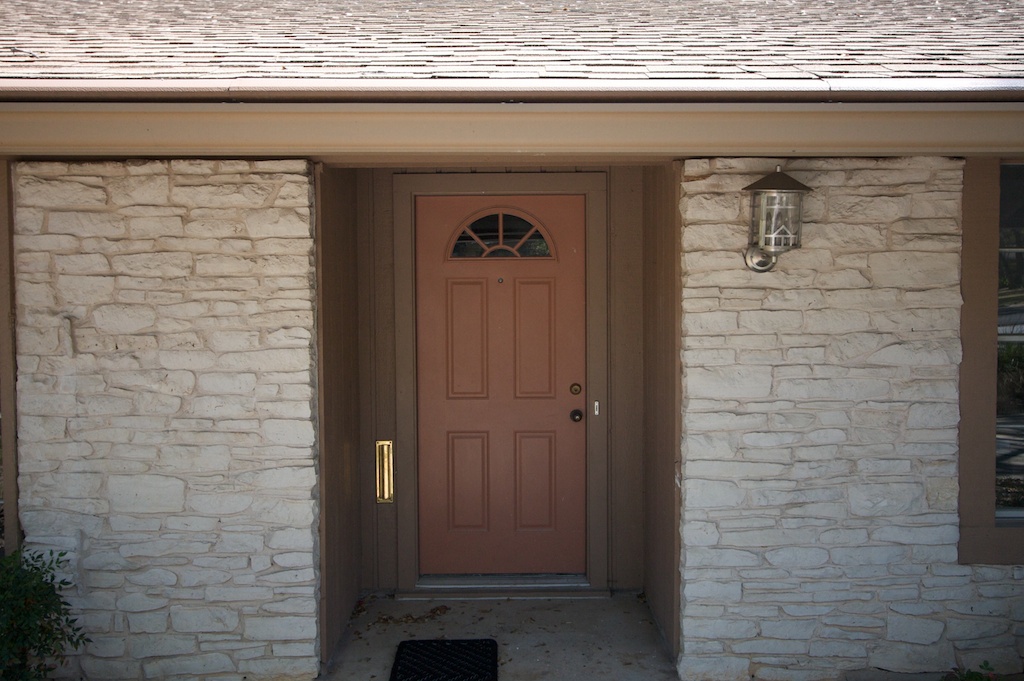
Very soon after we moved into the house, we visited a place in Austin called Crestview Doors. They were a custom door manufacturer (they’ve since basically gone out of business), and AEJ and I headed over there to talk to them about building the door that AEJ designed. Right. This was not just a new door — it was a custom door, conceived by AEJ. As Jonathan Newman said when I started describing this process, “you know, you can just buy a door, right?” Yes, but that wouldn’t be nearly as fun, and wouldn’t make AEJ as happy!
Probably 8 weeks later, we received the new door. Where the original door was the standard, off-the-Home Depot shelf 36″ door, the new door was a 48″-wide monster with insulated reeded glass.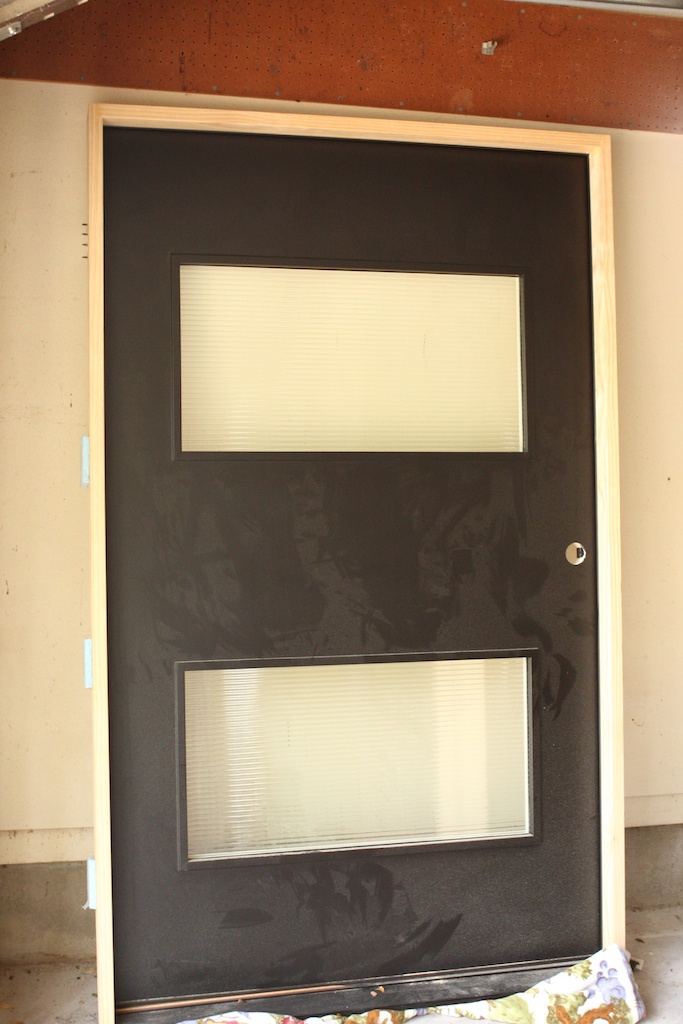
We had the door, but AEJ wasn’t done. At all. Her vision was not a standard door knob, but a massive center knob. She wanted it to be like a huge, shiny cabinet pull, right in the center of the door. Awesome! How hard could that be? HA. You have no idea — and neither did I.
The adventure started by visiting a place out in the boonies of Austin — a place called Austin Mac Fab. They’re an industrial steel fabrication company, specializing in welding, machining, and now, thanks to us — custom door knobs. (How does AEJ find these places?!) We talked to Jeremy at Mac Fab, and AEJ described what we were after. She showed him a drawing, and miraculously, he didn’t think this was an unusual request. I mean, we were at an industrial steel shop, asking for an 18-inch wide oval polished metal door knob. Jeremy, who was a really smart guy, thought that a great piece of starting material would be a tractor disk. This is a tractor disk.
His plan was to cut a large tractor disk into an oval shape, polish it, and figure out a way to securely mount this 45-pound piece of carbonized steel to our front door. Jeremy sent us — I’m not kidding — to a nearby tractor and farming retailer so we could see a tractor disk in person. So we drive up to this place in our Prius — it was the only non-pickup truck in sight — and the owner comes outside, thinking we’re obviously lost, and asks us in a thick Texas drawl, “can I haayylp you with sump’n?” He was very nice, but I’m not sure he quite understood our intensions. No matter; we had Jeremy order the tractor disk.
Several weeks later, we had our oval-shaped, polished tractor disk and mounting hardware. But it was raw carbonized steel — and AEJ wanted it to be shiny. First we went to a chroming company, thinking maybe we’d have it chromed — like a classic car bumper. The guy at the chroming place kept asking things like, “wait — you want to chrome plate a giant door knob? Why?” This wasn’t reassuring, and chrome wasn’t going to be right anyway, so we tried another place — Brady’s Distinctive Lighting in Central Austin.
How AEJ figured out that a lamp store would have the ability to nickel plate anything, let alone a massive door knob, I don’t know, but the owner, the amazing Betty Brady, who seems to have plated just about everything in the 40+ years she’s owned this store, didn’t question us at all. Somehow, this all made perfect sense to her. So we asked her to plate this huge thing in nickel. A few weeks later, we had a “knob,” which to me almost looked like a huge Texas-sized belt buckle for our big ass door.
So now we can just swap the doors, right? Well, not so much. Remember that the old door was a standard 36″ door — but the new one was 48″ wide? No problem — we just needed somebody to come cut a bigger hole in the front of the house.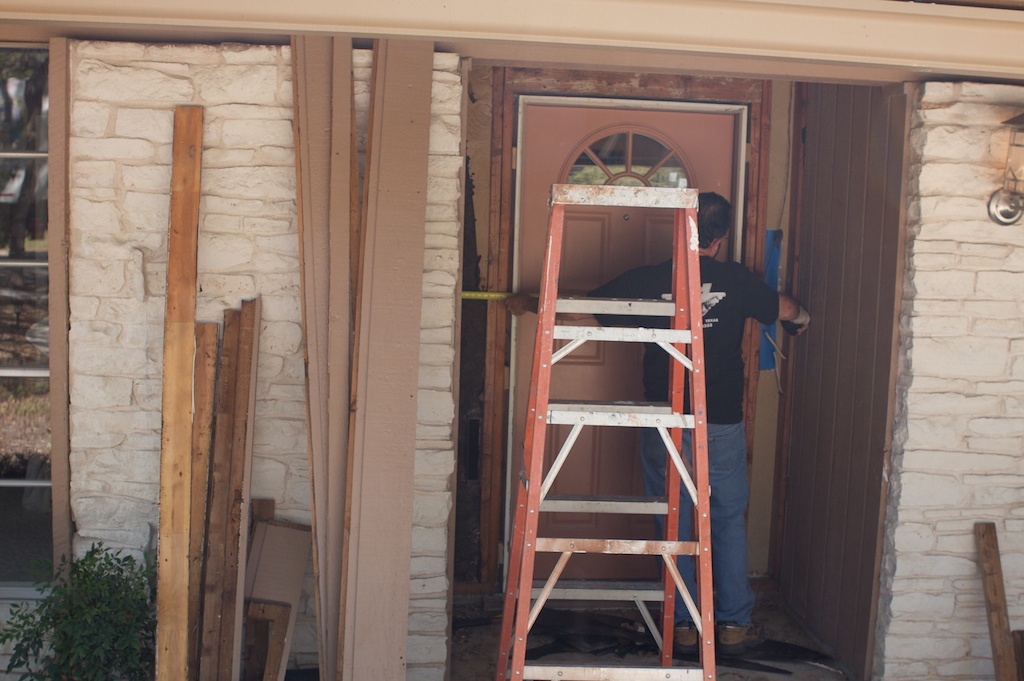
Yeah, that looks big enough.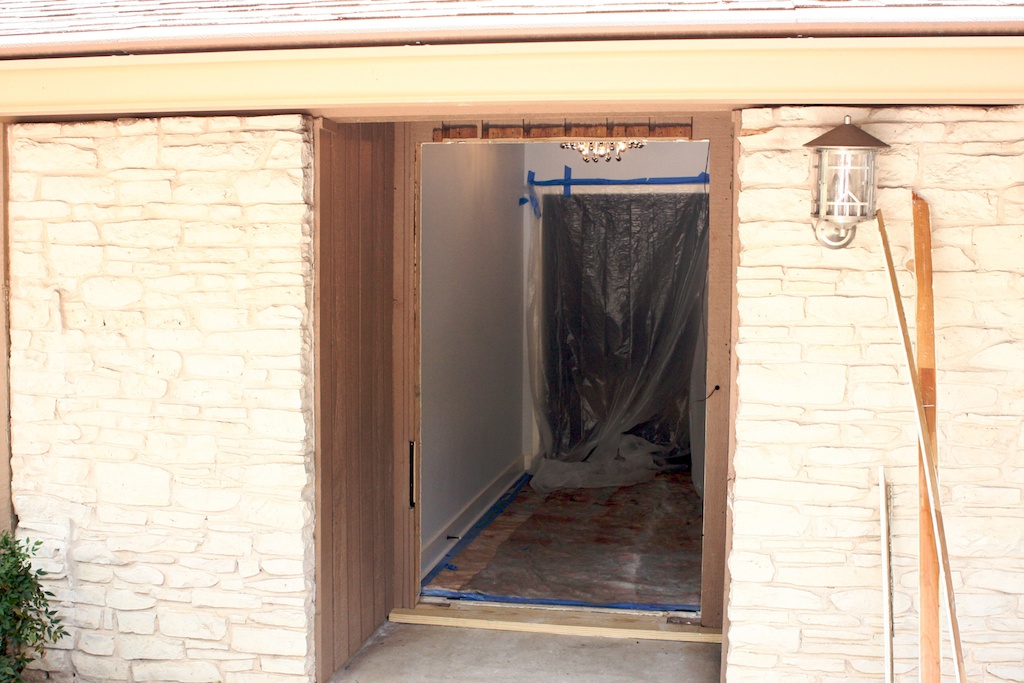
And with that, the old door was out…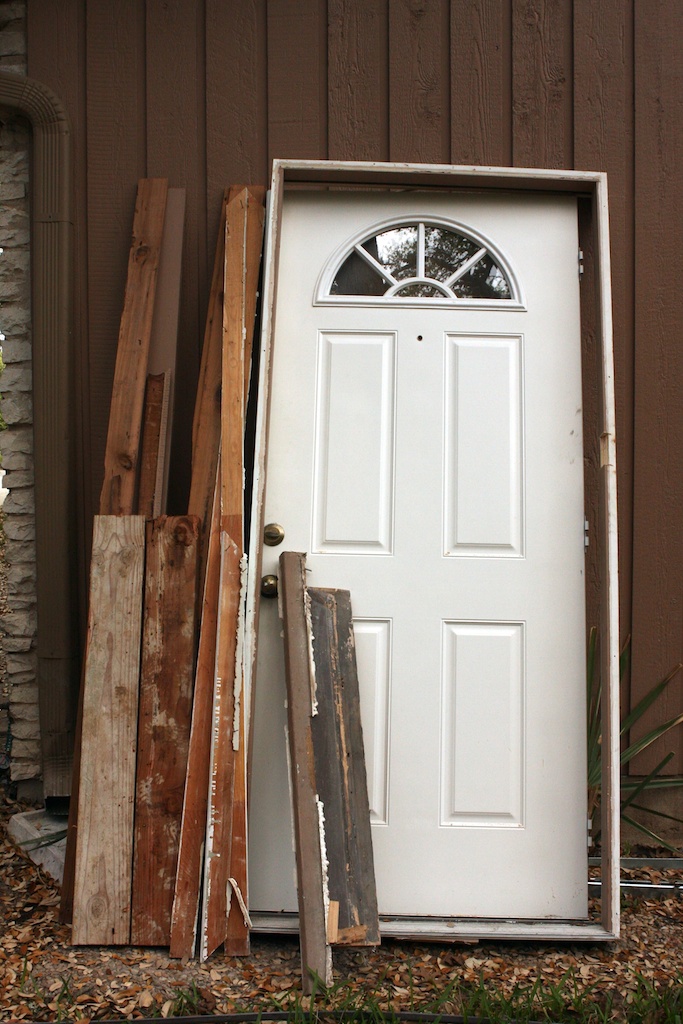
… and the new door was ready to go in.
Here’s what it looked like before the knob went on, and before the trim was painted.
Speaking of that knob again, there’s a funny thing on the knob that we couldn’t remove, and it’s become a cool little detail. The tractor disk was stamped with the manufacturer’s name. There was no way to completely sand it off, so it was plated over, but there’s still a ghost of that stamp on the knob.
So the door was in, but AEJ also wanted to update the lighting. The outside light went from this, which was kind of squished under the roof overhang…
… to this, a more modern fixture that hangs down, instead of sticking up.
Much more drastic was the lighting change inside the house. We went from this fixture, which hung so low that delivery guys kept slamming their heads into it…
… to this awesome alien-looking thing with chromed light bulbs.
It’s all done now, and it’s a huge improvement. It lets a HUGE amount more light into the house, and the exaggerated width accentuates the low-slung shape of the 60’s ranch-style house.
Before…
… and now.
Maybe even more striking is the inside of the house. Here’s the foyer when we bought the house. (This is before we changed the floors or anything; this was, I think, taken on the day we looked at the house. Note the sage green paint, and the wood panel on the wall.)
And here’s the foyer now. Oh, that raised stacked wood rectangle in the center of the door? AEJ had to design that, and have it custom built, too. It covers the massive bolts that are holding on the knob.
Another angle of the before…
… and now.
The whole project took months, with all of the research AEJ had to do to find vendors (for everything from the custom knob to the ball-catch that holds the door closed, since it doesn’t have a standard knob), to the construction, to the plating, to the installation, to the electrician who had to move outlets… It was such a long process — to put it in perspective, it took longer to complete than the kitchen remodel — that my motto for future renovations became “custom is a very bad word.” But now that it’s done, I see that as always, AEJ’s design eye was spot on. Even the FedEx guy wanted to talk about the door last week. AEJ has nailed yet another one.
Up next… the dining room.
July 15, 2009
Aurora Awakes – program note
“Aurora Awakes” finally has its official program note. Doug Martin, who commissioned the piece and conducted the premiere at Stuart High School, wrote a great note for the premiere, but it was somewhat specific to the premiere. I commissioned Jake Wallace — who wrote the program note for “Strange Humors,” and also wrote his DMA dissertation about my Soprano Sax Concerto — to write the note. (Jake, who just graduated from U. Georgia, will be the new Director of Bands at Southeastern Oklahoma State this fall.)
I’m excited and cautiously optimistic about the future of “Aurora Awakes.” There are some big performances coming up during 2009-2010, including concerts with the top band here at UT-Austin, at Oklahoma State, the University of Georgia, at the Midwest Clinic with the San Jose Wind Symphony, and — the big doozy — with the top Texas All-State Band in February. More than 2400 people have downloaded the MIDI audio, which seems completely crazy for a MIDI file. Granted, I think most of those downloads were from my dad, who seems to be the piece’s biggest fan. (For that reason, I dedicated the piece to him, a fact that he’s learning only by reading it here in the blog. Surprise, Dad.)
I think Jake Wallace nailed the program note, as he always does. It’s below…
Aurora now had left her saffron bed,
And beams of early light the heav’ns o’erspread,
When, from a tow’r, the queen, with wakeful eyes,
Saw day point upward from the rosy skies.
– Virgil, The Aeneid, Book IV, Lines 584-587
Aurora – the Roman goddess of the dawn – is a mythological figure frequently associated with beauty and light. Also known as Eos (her Greek analogue), Aurora would rise each morning and stream across the sky, heralding the coming of her brother Sol, the sun. Though she is herself among the lesser deities of Roman and Greek mythologies, her cultural influence has persevered, most notably in the naming of the vibrant flashes of light that occur in Arctic and Antarctic regions – the Aurora Borealis and Aurora Australis.
John Mackey’s Aurora Awakes is, thus, a piece about the heralding of the coming of light. Built in two substantial sections, the piece moves over the course of eleven minutes from a place of remarkable stillness to an unbridled explosion of energy – from darkness to light, placid grey to startling rainbows of color. The work is almost entirely in the key of E-flat major (a choice made to create a unique effect at the work’s conclusion, as mentioned below), although it journeys through G-flat and F as the work progresses. Despite the harmonic shifts, however, the piece always maintains a – pun intended – bright optimism.
Though Mackey is known to use stylistic imitation, it is less common for him to utilize outright quotation. As such, the presence of two more-or-less direct quotations of other musical compositions is particularly noteworthy in Aurora Awakes. The first, which appears at the beginning of the second section, is an ostinato based on the familiar guitar introduction to U2’s “Where The Streets Have No Name.” Though the strains of The Edge’s guitar have been metamorphosed into the insistent repetitions of keyboard percussion, the aesthetic is similar – a distant proclamation that grows steadily in fervor. The difference between U2’s presentation and Mackey’s, however, is that the guitar riff disappears for the majority of the song, while in Aurora Awakes, the motive persists for nearly the entirety of the remainder of the piece:
“When I heard that song on the radio last winter, I thought it was kind of a shame that he only uses that little motive almost as a throwaway bookend. That’s my favorite part of the song, so why not try to write an entire piece that uses that little hint of minimalism as its basis?”
The other quotation is a sly reference to Gustav Holst’s First Suite in E-flat for Military Band. The brilliant E-flat chord that closes the Chaconne of that work is orchestrated (nearly) identically as the final sonority of Aurora Awakes – producing an unmistakably vibrant timbre that won’t be missed by aficionados of the repertoire. This same effect was, somewhat ironically, suggested by Mackey for the ending of composer Jonathan Newman’s My Hands Are a City. Mackey adds an even brighter element, however, by including instruments not in Holst’s original:
“That has always been one of my favorite chords because it’s just so damn bright. In a piece that’s about the awaking of the goddess of dawn, you need a damn bright ending — and there was no topping Holst. Well… except to add crotales.”
View Comments
Comments
I just wanted to say this piece is simply astounding with the multiple time changes and key changes. Being first chair alto sax, it's quite a lot of work! We also played "Undertow" and thought that couldn't have been outbeat, but officially "Aurora Awakes" has done it...well done! My director (Moatsie, as affectionately called by us) said you'd be coming (either that or I can't hear well) so I can't wait to listen to how you want us fine tuned....which, looking by some solos, is still a long way off.
A fellow musician
Add comment
July 13, 2009
Sultana for sax and piano
Over a year ago, Timothy Roberts, saxophone soloist with the United States Navy Band, asked me to arrange “Wood,” the 4th movement of my Concerto for Soprano Sax, for sax and piano alone. Lots of people have asked me to make a piano reduction of the entire concerto, and that’s not something I have the time to do. The idea of having a standalone version of “Wood” that could be played on recitals and at solo and ensemble contests, though, was both a great idea, and something that didn’t take all that long to do. Well, once I finally started it. Yesterday.
So, it’s done. After 24 hours, I have a “new” piece: “Sultana,” for saxophone and piano. In trying to come up with a title for the standalone version, we played with this idea that it sounds vaguely North African — sort of like Algiers or Marseilles, with that sort of French-but-more-ethnically-ambiguous sound. It was tough to find a title that didn’t need the word “tango” in it, since this piece is so obviously a tango. I was tempted — yes, I have two pieces with “tango” in the title, but how many pieces did Joplin write that used the word “Rag” and how many times did Sousa write something with “March” in the title? Still, that was the obvious thing, so we didn’t go that direction. Instead, AEJ came up with “Sultana,” the word for a female sultan (and also the word for a sultan’s “main” wife). There haven’t been many female sultans, but there actually was on in Algiers, of all places.
“Sultana” is a slightly modified transcription of “Wood,” with just a few extra notes in the solo part. Although I intend it to be played on a soprano sax, I’ll be including both Eb and Bb solo parts in all sets that I sell ($20 plus shipping! A steal!), so you could play it on soprano, alto, tenor, or I suppose even baritone sax. (If you do that, please send me a recording; I’d be most curious to hear the piece on a bari, although I wouldn’t expect it to sound… what’s the word? Good.)
Seriously, though I’m curious to hear this arrangement at all. If you ever play it, I hope you’ll send me a recording!
I’m off… It’s cookie time!
View Comments
Comments
I would like some credit.
Thank you.
It's official - AEJ's intelligence intimidate me.
Heck, it's taking me quite a bit of time, an online dictionary and several revisions for me to get this comment just right, knowing that she may just see it.
~C
View Comments
Comments
Courtney says
I think that you guys have improved the value of your home by about 52 quadrillion dollars since you bought it. What a cool place to call home!
Connie Miller says
You two make an amazing team. She with the vision and ability to find folks to turn it into a reality, and you who is supportive and excited.
Most of us will have to live vicariously through you because we either don't have the vision, the funds or the supportive partner to change it up and go for the glitz and glam.
So, which magazines are going to do a spread on the place?
amerikan kapı says
I think that you guys have improved the value of your home by about 52 quadrillion dollars since you bought it. What a cool place to call home!
Kelsey says
Honestly, I'm not sure I'm in love with the giant doorknob, but I have to say, it's really quite cool-looking, and I love how single-minded your wife seems to be about her designs!
Add comment